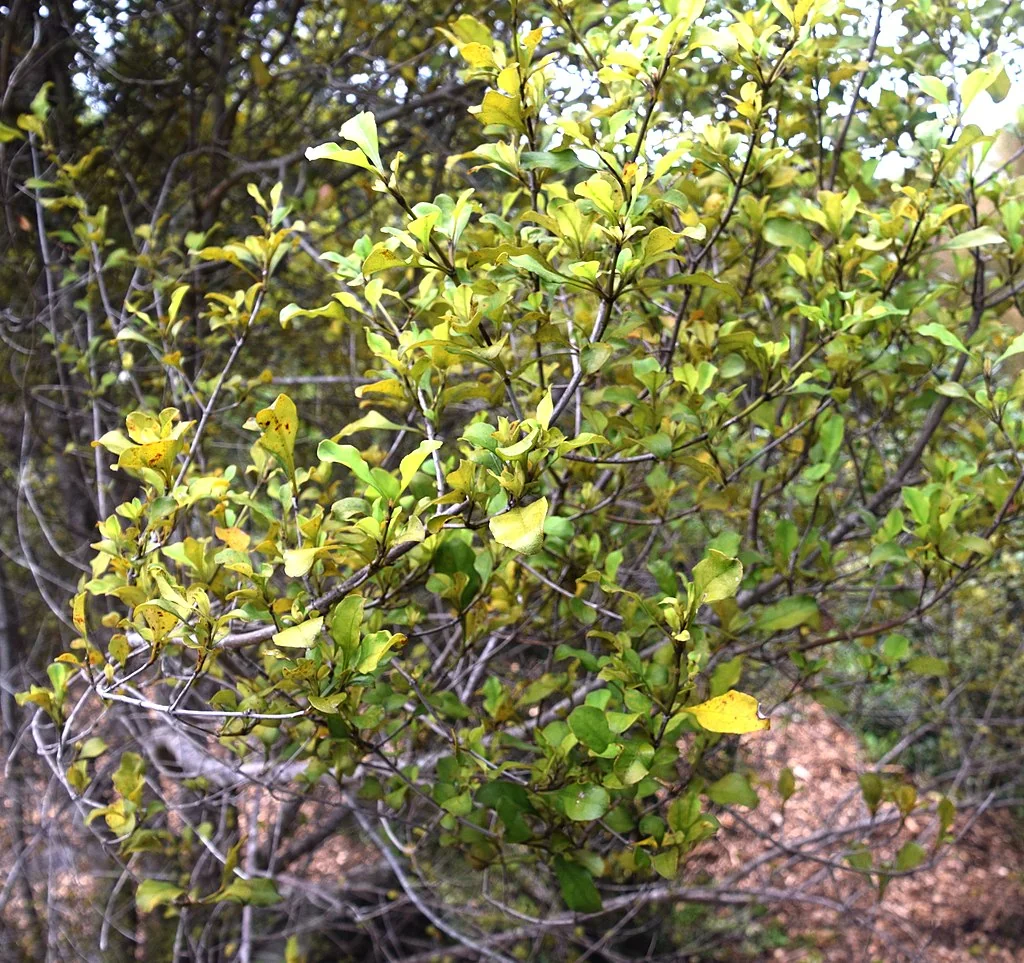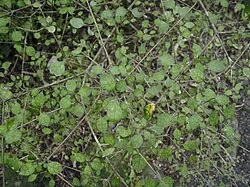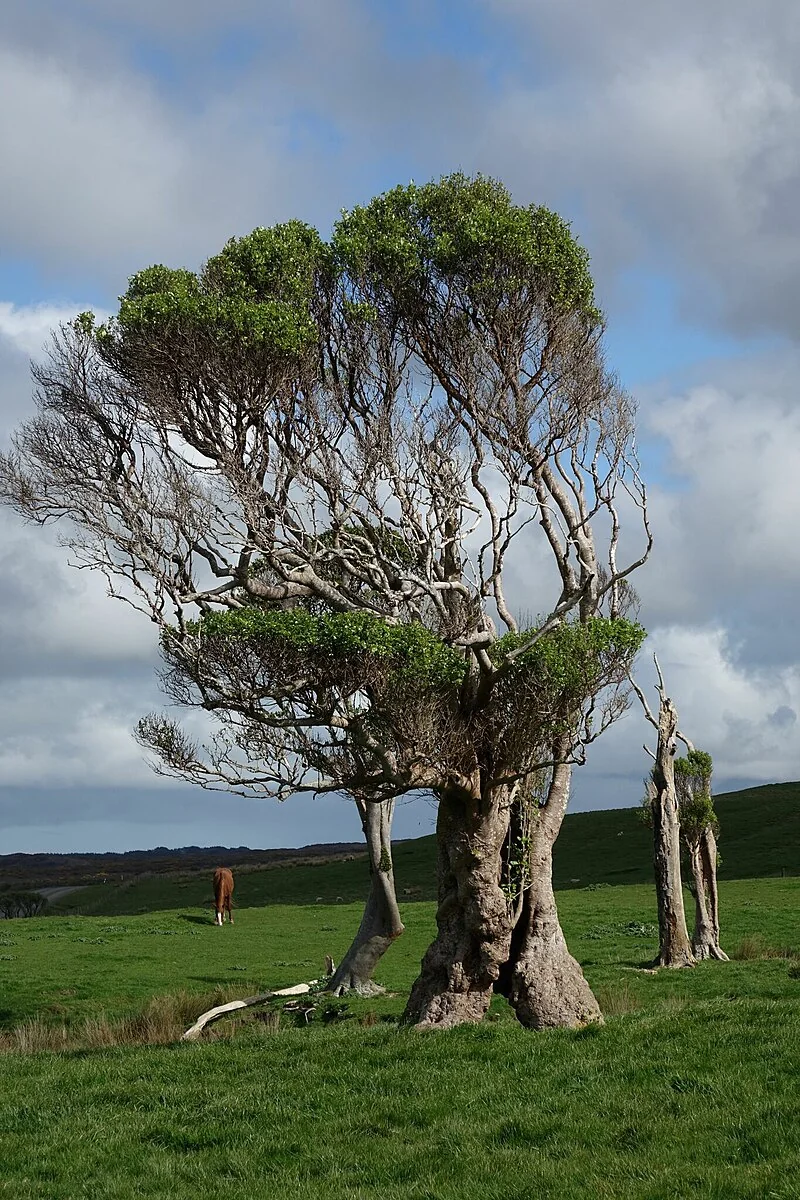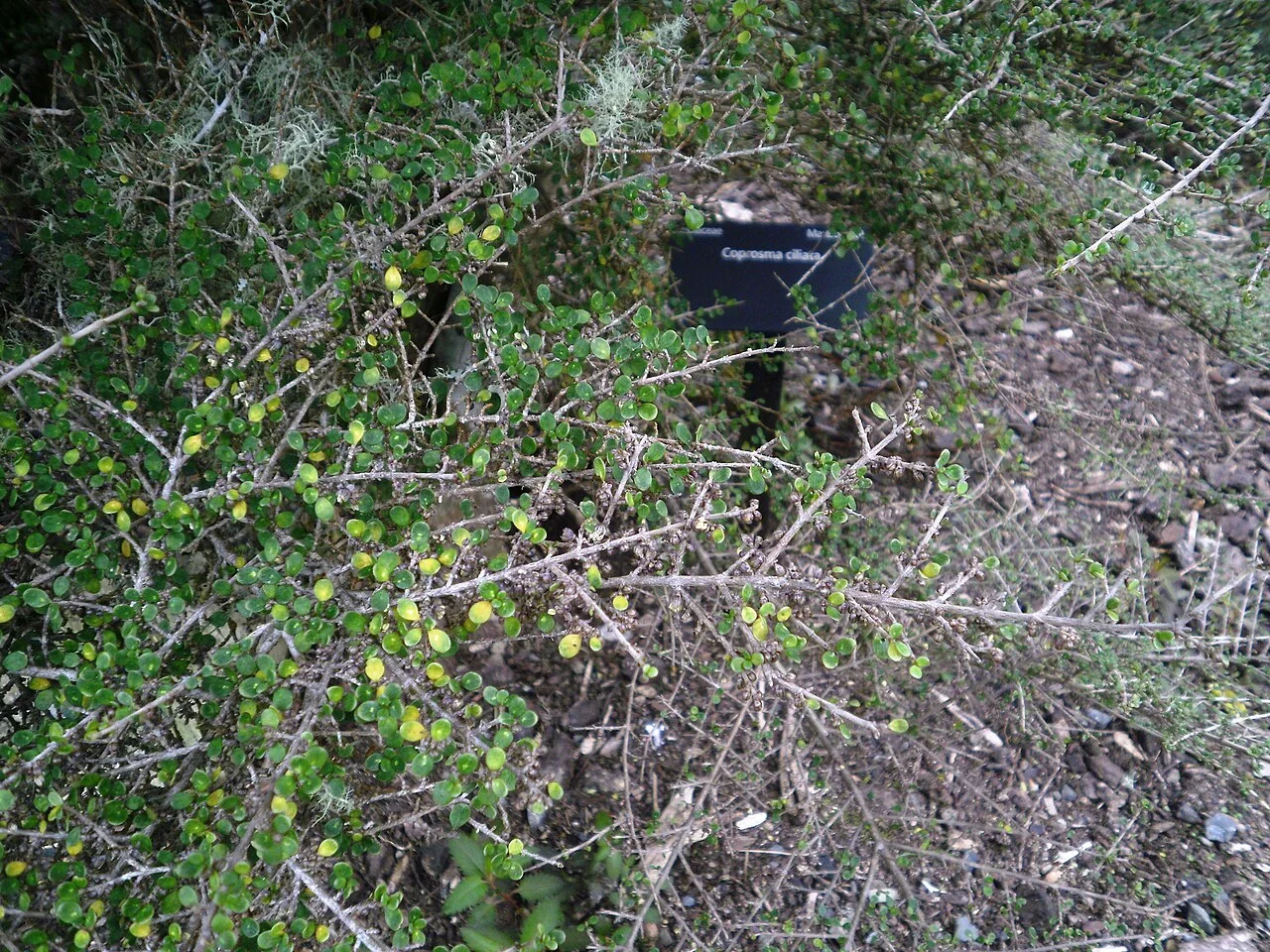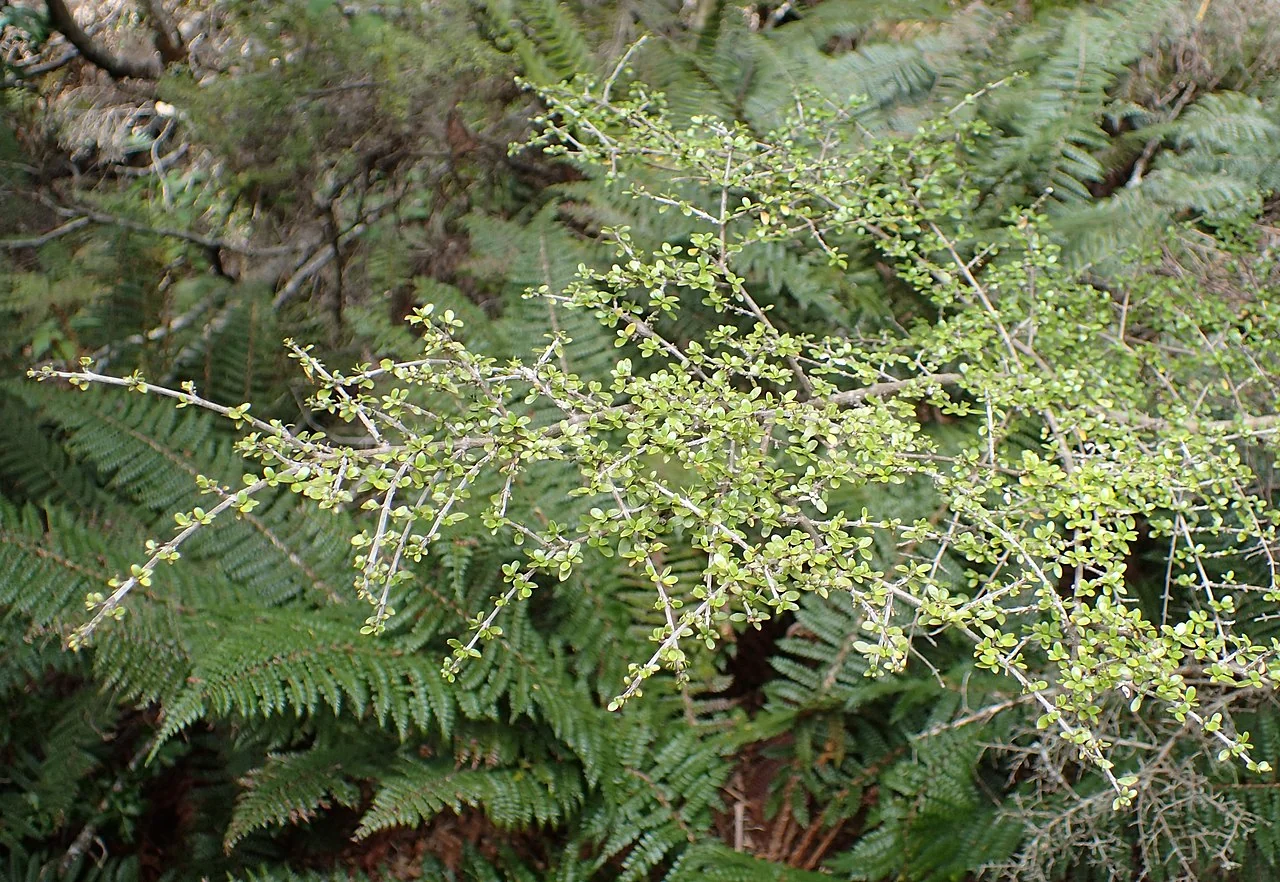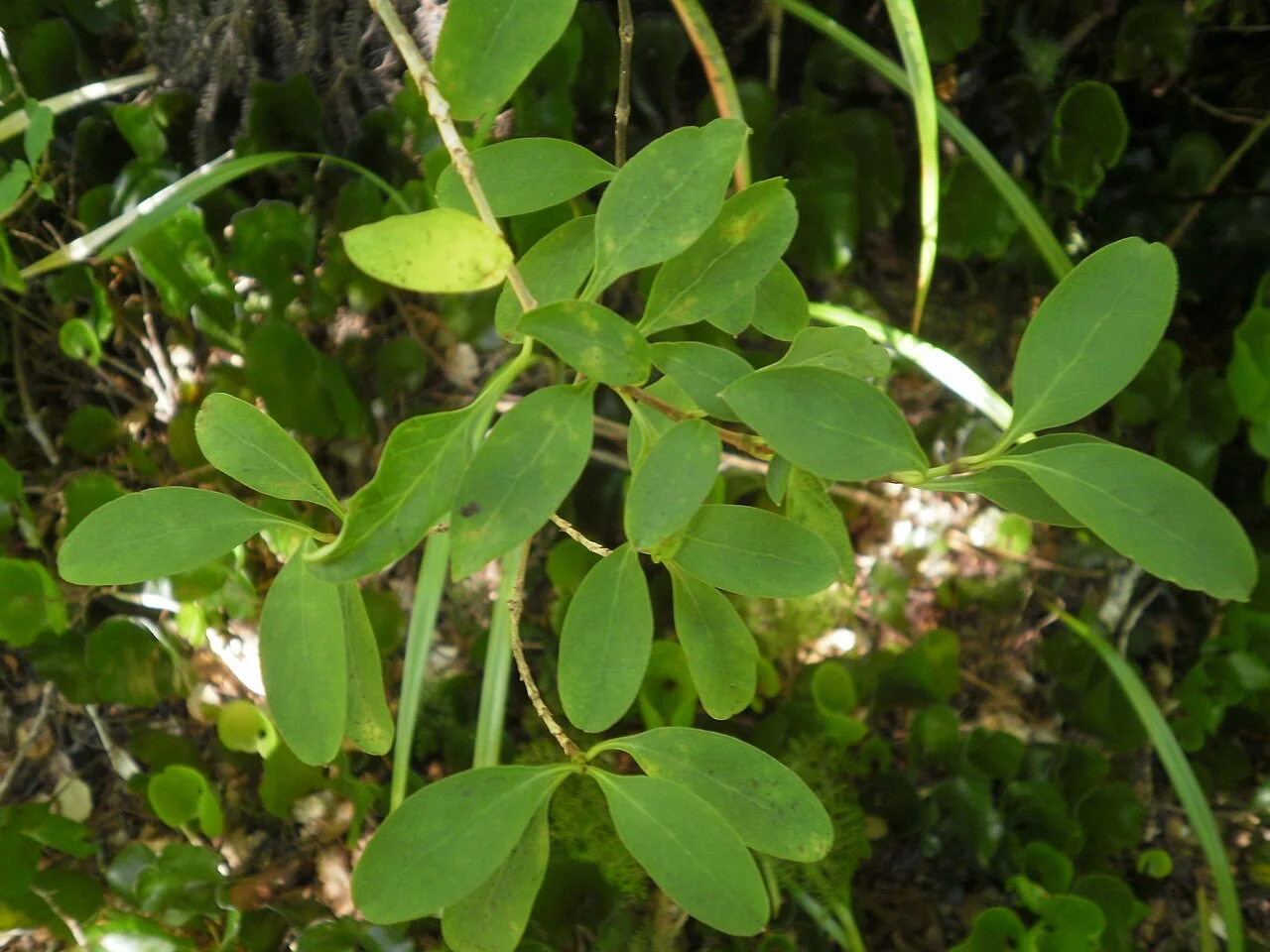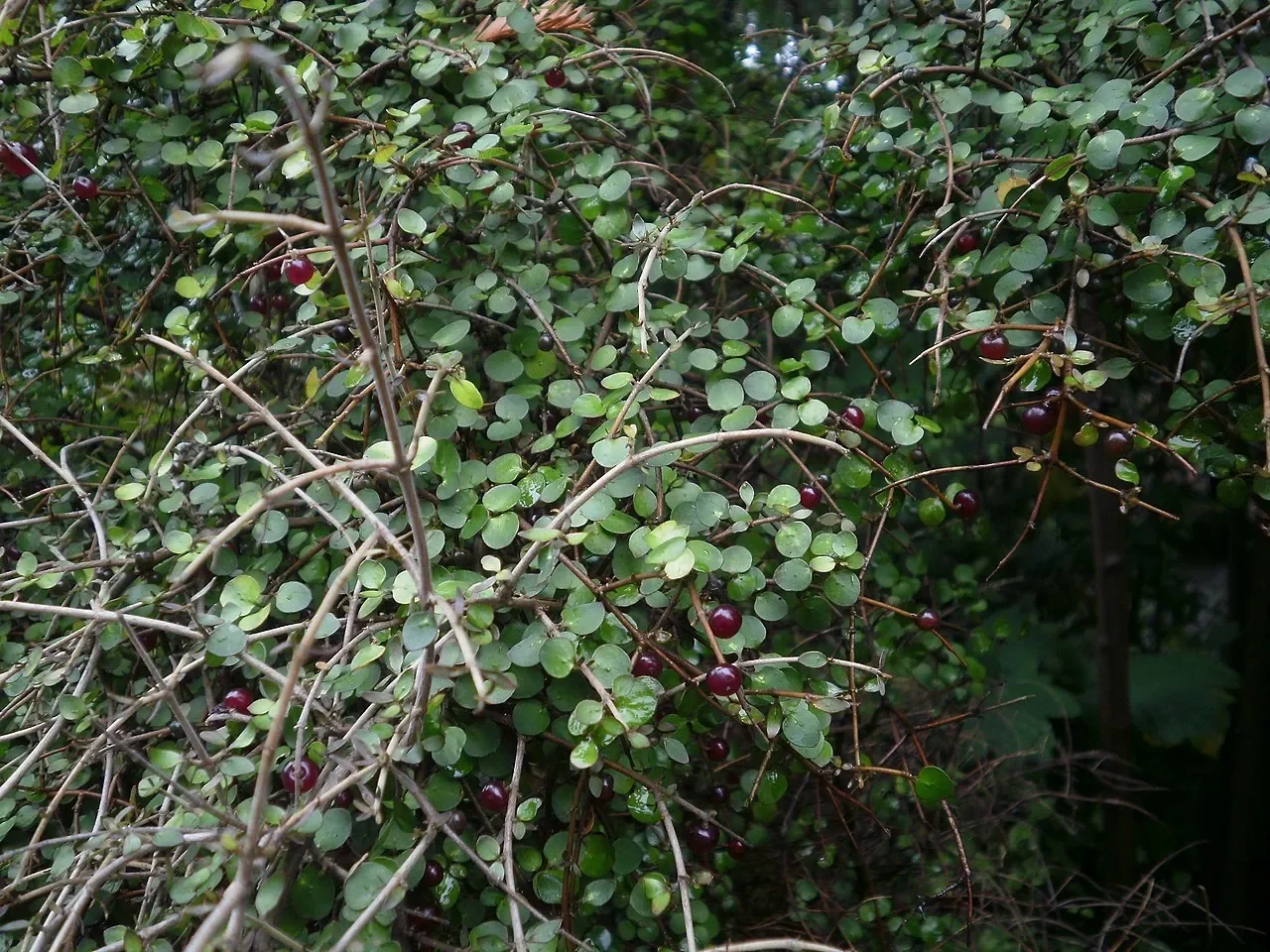
Twiggy Coprosma
Coprosma rhamnoides
Introduction
Introduction Overview
Twiggy Coprosma, known scientifically as Coprosma rhamnoides , is a distinctive small-leaved native shrub characterized by its intricate network of fine, interlacing branches that create an attractive divaricating or zigzag growth pattern typical of many New Zealand natives . This hardy , drought-tolerant shrub typically grows 1-3 meters tall with a similar spread, featuring tiny linear to oblong leaves just 3-8mm long that cluster along the slender twigs, giving the plant its common name and creating a delicate, fine-textured appearance. Found naturally throughout New Zealand from coastal areas to montane regions, Twiggy Coprosma produces small inconspicuous flowers followed by small orange to red berries that are highly valued by native birds, making it an excellent choice for wildlife gardens and restoration plantings where its tough constitution and attractive branching structure provide both ecological benefits and year-round visual interest in challenging growing conditions. native shrubs .

Plant Description
Botanical Features
Coprosma rhamnoides , commonly known as Twiggy Coprosma or Mingimingi, is an evergreen shrub endemic to New Zealand. It typically grows up to 2 meters tall, characterized by its dense, tightly divaricating (interlaced, twiggy) branches. Its leaves are tiny, simple, and variable in shape, usually light green but can turn purple in full sun, often appearing in bundles. Small pits, known as domatia, are found on the underside of the leaves. In mid-spring, it produces inconspicuous, small, pale cream flowers. It is dioecious, with female plants bearing small (3-4mm) dark red berries, or drupes, in autumn, which ripen to a dark red or black colour. This shrub is widespread in lowland to lower montane-scrubland and forests throughout New Zealand, thriving in full sun or dry, exposed conditions, and prefers well-drained, moist, mildly acidic to neutral soils.
Quick Facts
Quick Facts Overview
| Scientific Name | Coprosma Rhamnoides |
|---|---|
| Height | 1-3 m (3-10 ft) tall |
| Spread | 1-2 m (3-6 ft) wide |
| Water Needs | Low to moderate; drought-tolerant once established |
| Light | Full sun to part shade |
| Frost Tolerance | High (tolerates moderate frosts) |
| Salt Tolerance | Moderate (tolerates some coastal exposure) |
| Growth Rate | Moderate to fast (especially in good conditions) |
| Lifespan | Long-lived (several decades in suitable conditions) |
Climate Best Suited to
Coprosma is highly adaptable and found throughout New Zealand, from coastal to montane regions. It tolerates a wide range of conditions, including wind, frost, and drought.
Regional Suitability
| City | Climate Suitability |
|---|---|
| Whangārei | Ideal |
| Auckland | Ideal |
| Hamilton | Ideal |
| Tauranga | Ideal |
| Rotorua | Ideal |
| Gisborne | Ideal |
| New Plymouth | Ideal |
| Napier | Ideal |
| Whanganui | Ideal |
| Palmerston North | Ideal |
| Wellington | Ideal |
| Nelson | Ideal |
| Christchurch | Ideal |
| Dunedin | Ideal |
| Invercargill | Ideal |
Natural Habitat
Natural Habitat Overview
Coprosma is naturally found in specific habitats throughout New Zealand. Understanding its natural environment helps in providing appropriate growing conditions in cultivation.
Plant Conservation
The conservation status of Coprosma rhamnoides is "Not Threatened" as of 2023. This status has been consistent in previous assessments from 2017, 2012, 2009, and 2004.
Soil Requirements
Prefers well -drained soils but is tolerant of a range of soil types, including clay and sandy soils.
- Well-drained to moderately moist soils
- Tolerates poor and dry soils
- pH 5.5-7.5 (acidic to neutral)
Light Requirements
Grows well in full sun to part shade.
- Full sun for compact growth
- Part shade tolerated, especially in hotter regions
Water Requirements
Low to moderate water needs once established.
- Water regularly during establishment
- Drought-tolerant once mature
- Avoid waterlogged soils
Planting Guide
When to Plant
Best planted in autumn or spring when soil is moist and temperatures are mild.
Site Selection
- Choose a sunny or partly shaded, well-drained site
- Ideal for mixed native plantings and hedges
Planting Procedure
- Prepare soil by removing weeds and loosening to a depth of 30cm
- Dig a hole just large enough for the root ball
- Plant at the same depth as in the pot
- Backfill and firm gently
- Water in well
Ecological Role
Wildlife Interactions
Coprosma plays an important ecological role in New Zealand's native ecosystems. It provides habitat and food for native wildlife and contributes to ecosystem health and biodiversity.
Uses and Significance
Coprosma rhamnoides , also known as Twiggy Coprosma or Mingimingi, is a New Zealand native shrub with various uses and significant ecological and cultural importance.
Landscaping:
- It is an excellent choice for landscaping projects, often included in mixed plantings, woodland gardens, and around stream and pond areas. It can be trimmed into a hedge or grown as an informal hedge and is ideal for areas with poor soil, wind, or frost.
Ecological Restoration:
- Due to its hardiness and adaptability, it's used in revegetation projects and as understory planting in native bush areas.
Wildlife Attraction:
- The plant provides food (berries) for native birds, insects, and lizards, contributing to ecosystem health and biodiversity.
Soil Stabilization:
- It helps stabilize soil and prevent erosion.
Edible Uses:
- The dark red fruit can be eaten raw or cooked, though it has little flavor. The roasted seeds can also be used as a coffee substitute.
Landscaping Uses
Landscaping Uses Overview
Coprosma is highly valued in landscaping for its aesthetic appeal and practical benefits. It can be used in various garden styles and landscape applications.
Seasonal Care Calendar
Spring
- New growth emerges
- Prune lightly to shape if needed
- Mulch to retain moisture
Summer
- Peak berry production
- Water during extended dry spells
- Monitor for pests (rare)
Autumn
- Berries ripen and are eaten by birds
- Remove dead or damaged branches
Winter
- Generally dormant
- Minimal care required
Pruning and Maintenance
Pruning and Maintenance Overview
Coprosma generally requires minimal pruning. Remove dead or damaged growth as needed and shape the plant to maintain desired form. Pruning is best done in late winter or early spring before new growth begins.
How to Grow Twiggy Coprosma
From Fresh Red Drupes
Fresh red drupe propagation represents the most natural and reliable method for growing Twiggy Coprosma, taking advantage of this hardy endemic species' exceptional fruit production and natural dispersal strategy that has enabled it to establish across diverse New Zealand environments throughout North, South, and Stewart Islands. This remarkably resilient endemic produces abundant small pale cream flowers in October followed by red drupes that ripen to dark red-black, providing excellent opportunities for propagation while supporting the species' natural frugivory dispersal cycles essential for ecosystem function across New Zealand's varied landscapes. The species' extraordinary adaptation to harsh conditions including high wind and weather exposure in sunny or rainy environmental conditions makes it particularly valuable for challenging garden situations and restoration projects requiring plants capable of handling extreme environmental stress while providing important wildlife resources through berry production. Fresh drupe propagation allows cultivation of genetic diversity essential for healthy populations while enabling gardeners to appreciate the remarkable hardiness that has made this species valuable for habitat restoration and windbreak applications where other plants might struggle. Collect ripe red drupes during autumn from March to April when fruits have achieved their characteristic red coloration and are beginning to ripen to dark red-black, timing collection to coincide with peak seed maturity for optimal viability and germination success. Choose drupes that are fully developed, firm, and show good colour development typical of mature fruit, avoiding any that appear damaged, diseased, or prematurely dropped which might indicate compromised seed quality or reduced viability. Process drupes immediately after collection to remove fleshy pulp that could inhibit germination, using gentle washing techniques under running water to separate clean seeds from fruit material that could promote fungal growth during establishment. Clean seeds thoroughly by repeated washing until all fruit debris is removed, as any remaining pulp can significantly interfere with germination success in coprosma species, retaining viable seeds while discarding any floating material that indicates poor quality. Prepare optimal germination medium using well-draining seed-raising mix with good moisture retention characteristics, ensuring growing conditions that support healthy development for this adaptable species tolerant of various soil conditions. Sow fresh seeds immediately after processing onto firm bed of seed-raising mix, covering lightly with additional mix and watering thoroughly to provide optimal conditions for the relatively rapid germination typical of this species. Provide optimal environmental conditions including consistent temperatures and bright light that supports germination while maintaining steady moisture without waterlogging throughout the 2-3 month germination period characteristic of this hardy species. Maintain careful moisture management throughout the germination period, ensuring growing medium remains consistently moist but never waterlogged while monitoring for emergence signs that typically occur within 4-8 weeks under optimal conditions. Young seedlings develop at moderate rates while establishing the robust root systems necessary for adaptation to challenging growing conditions, requiring protection from extreme environmental stress during early establishment phases when they are most vulnerable. Transplant successful seedlings when they reach 5-8cm height into individual pots using a well-draining potting mix, and grow them on for at least one full growing season before planting out. Seed-grown plants typically take 2-3 years to reach flowering size and may show natural variation in leaf width, flower size, and overall plant vigor. This variation can be valuable for restoration projects where genetic diversity is desired, though division is preferred when specific cultivar characteristics must be maintained.
From Semi-Hardwood Cuttings
Semi-hardwood cutting propagation offers an excellent vegetative method for growing Twiggy Coprosma that preserves the exact genetic characteristics of superior parent plants while providing reliable results for gardeners seeking to maintain specific hardiness traits, growth habits, or wind tolerance characteristics that make exceptional specimens particularly valuable for challenging site applications. This approach is particularly valuable for propagating plants that demonstrate superior weather resistance, enhanced wind tolerance, or other desirable traits that can be preserved through careful vegetative propagation techniques suited to this easily rooted hardy species. The method works exceptionally well with Twiggy Coprosma because of this species' natural ability to develop adventitious roots readily under appropriate growing conditions, making it suitable for both home propagation and large-scale restoration projects requiring reliable plant production for challenging sites. Take 8-10cm semi-hardwood cuttings during autumn to mid-spring when growth has achieved optimal maturity for rooting while retaining sufficient vigor for successful establishment under controlled propagation conditions. Select healthy, vigorous shoots from middle portions of branches that display the characteristic small rounded leaves attached directly to stems and the robust twiggy growth typical of healthy Twiggy Coprosma development, avoiding both very soft growth and completely hardened wood that may resist rooting. Cut sections with clean, sharp secateurs just below nodes, ensuring each cutting includes at least 2-3 nodes while selecting material that represents the best characteristics of the parent plant including dense growth habit and the hardy characteristics that make this species so valuable for difficult sites. Remove lower leaves carefully to reduce transpiration stress while retaining sufficient photosynthetic capacity in upper leaves, taking care not to damage the small leaves that provide energy for root development during the establishment period. Create a light nick at the base of cutting to expose more tissue where new roots will develop most readily, using gentle techniques that enhance root initiation without causing excessive damage to cutting material. Apply rooting hormone by dipping cutting base for 5-10 seconds in appropriate formulation, using hormone concentrations suited to semi-hardwood coprosma species to enhance root initiation success rates. Insert prepared cuttings into well-draining propagation growing media composed of quality propagation medium with excellent drainage characteristics, ensuring optimal growing conditions that support rapid root development without creating waterlogged conditions. Maintain optimal environmental conditions including misting systems and bottom heat application that support rapid root development, providing consistent temperatures around 18-22°C and high humidity levels that prevent cutting stress. Provide bright, indirect light that supports photosynthesis without causing excessive stress to cutting material, replicating the hardy growing conditions where this species naturally thrives in exposed environments. Monitor cutting development throughout the 3-4 week rooting period, maintaining consistent environmental conditions while watching for signs of successful root development including new shoot growth and resistance when gently tested for root establishment. Root development occurs rapidly as cuttings establish the fibrous root systems characteristic of mature Twiggy Coprosma adapted to challenging growing conditions, typically showing successful establishment within three weeks under optimal propagation conditions. Pot successful cuttings into well-drained mix and provide gradual hardening off before planting into permanent positions, ensuring successful transition to landscape cultivation where they can develop their characteristic hardy, twiggy habit and wind tolerance. This easy method makes Twiggy Coprosma an excellent choice for propagating hardy plants for challenging sites while maintaining the genetic characteristics that make specific specimens particularly valuable for windbreak and habitat restoration applications.
From Hardy Windbreak Establishment
Hardy windbreak establishment provides an excellent approach to growing Twiggy Coprosma that maximizes this species' extraordinary tolerance to harsh conditions while creating effective wind protection and wildlife habitat features that demonstrate the remarkable resilience of this endemic species capable of thriving under high wind and weather exposure. This method is particularly valuable for gardeners and land managers dealing with challenging exposed sites requiring plants capable of handling extreme environmental conditions while providing practical landscape benefits including wind protection, low hedging, and wildlife habitat through berry production that attracts native frugivorous birds. Twiggy Coprosma serves as an exceptional windbreak plant due to its natural dense, interlaced branching structure, exceptional weather tolerance, and ability to establish in the most hardy conditions while providing year-round protection and seasonal wildlife resources. Begin by identifying exposed sites requiring wind protection that present challenging growing conditions where other plants might struggle, considering factors including prevailing wind directions, soil drainage characteristics, and integration with existing landscape features that benefit from protective windbreak establishment. Design windbreak plantings that incorporate Twiggy Coprosma as a primary component of protective barriers, spacing plants to encourage natural development of dense, interlaced branching while allowing adequate room for individual plant development and windbreak effectiveness. Source multiple plants through combination of seed-grown specimens, cutting‑propagated plants, and nursery stock to ensure genetic diversity and windbreak uniformity while maintaining the natural variation that supports healthy plant community establishment under challenging conditions. Prepare planting sites by improving drainage where necessary while accepting that this hardy species can survive in poorer soil conditions, creating basic growing conditions that support establishment without requiring extensive site modification. Space windbreak plants 1-1.5 m apart to encourage proper lateral growth development and windbreak density formation while allowing adequate room for the characteristic twiggy growth that provides effective wind protection as plants mature. Plant during optimal seasonal windows when environmental conditions support establishment, though this hardy species can tolerate planting under less-than-ideal conditions due to its exceptional environmental tolerance and establishment ability. Integrate with complementary hardy native species that enhance windbreak effectiveness while providing diverse habitat structure, creating protective barriers that support various native wildlife species while maintaining practical landscape protection functions. Create effective windbreak structure by varying planting positions according to site topography and wind exposure patterns, establishing protective barriers that address specific site conditions while maximizing the natural hardy characteristics of this resilient species. Implement minimal maintenance regimes that allow natural windbreak development while providing basic establishment support, ensuring plantings develop their characteristic hardy form while requiring minimal ongoing intervention once established. Monitor windbreak establishment success through wind protection assessment and plant performance evaluation, documenting effectiveness and adjusting planting approaches to enhance protective value while maintaining the low-maintenance characteristics that make this species valuable. Allow natural ecological processes including wildlife utilization of berries and natural plant community development to enhance windbreak value, creating dynamic landscape features that provide practical benefits while supporting native biodiversity and demonstrating successful adaptation to challenging environmental conditions.
Pests and Diseases
Common Pests
Coprosma is generally resistant to most pests due to its native adaptations. However, it may occasionally be affected by common garden pests such as aphids or scale insects.
Disease Prevention
To prevent diseases, ensure good air circulation around Coprosma and avoid overwatering. Remove any diseased plant material promptly to prevent spread.
Cultural Significance
Traditional Uses and Values
Coprosma rhamnoides , also known as twiggy coprosma or red-currant coprosma, holds significant cultural importance, particularly for Māori communities in New Zealand. In Māori tradition, this plant was valued for its practical applications and spiritual significance. Historically, Māori utilized Coprosma rhamnoides for various traditional purposes, including medicine, food, and other cultural practices. Its presence in traditional landscapes and its diverse uses highlight its importance beyond its ecological value. The plant continues to be relevant in contemporary Māori culture and environmental stewardship. Beyond its spiritual and traditional ceremonial roles, Coprosma rhamnoides also had practical uses: the fruit can be consumed raw or cooked, the roasted seeds can be used as a coffee substitute, and a yellow dye can be extracted from the wood of the plant.
Bonus Tip
Expert Growing Advice
Don't be alarmed if you notice the new growth on your Twiggy Coprosma ( Coprosma rhamnoides ) has a brownish or greyish appearance. This is a natural characteristic of the plant and is thought to be a defensive mechanism to deter browsing animals. As the leaves mature, they will turn to their usual green colour. This unique feature adds another layer of interest to this already fascinating native shrub.


